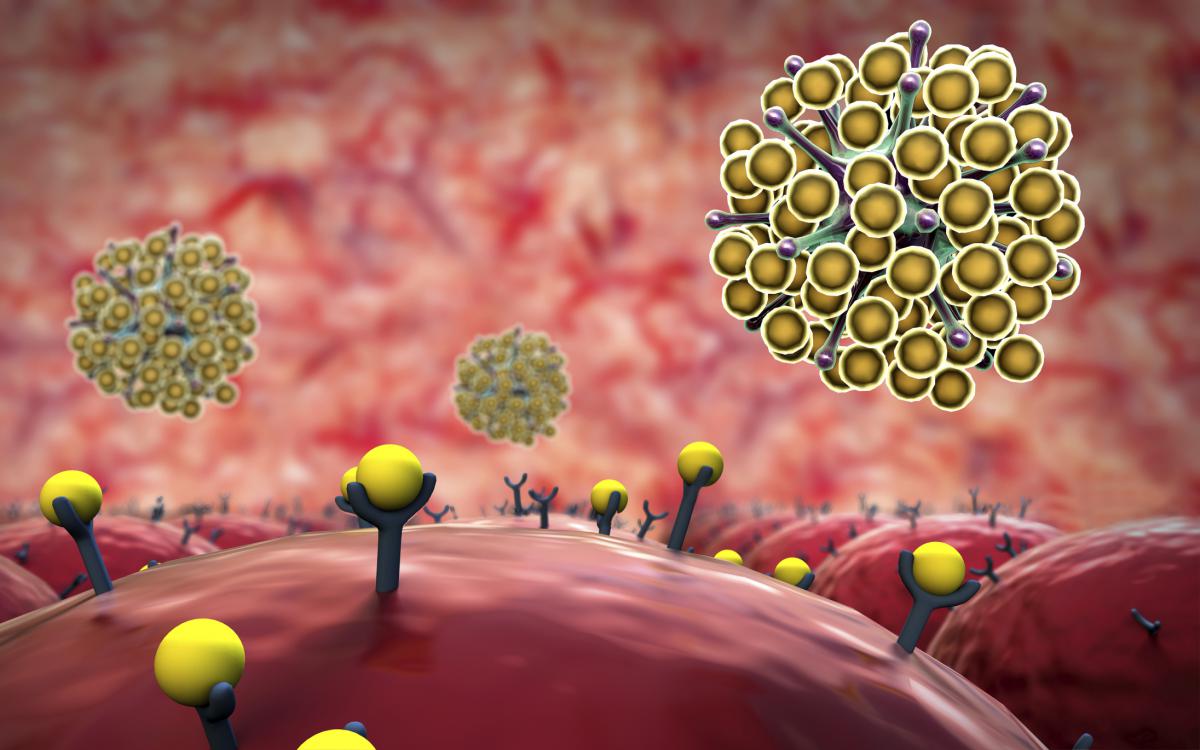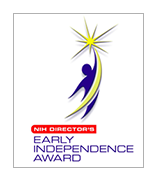Science Highlights Archive
Sports Leagues Promote Unhealthy Food and Beverages to Children
 Food and beverage companies spend millions of advertising dollars on professional sports organizations to reach young audiences. However, a question that often goes unasked is: what kind of messages about health are the advertisements sending to children? Thanks to the efforts of Early Independence Awardee, Marie Bragg, this overlooked aspect of marketing is being researched.
Food and beverage companies spend millions of advertising dollars on professional sports organizations to reach young audiences. However, a question that often goes unasked is: what kind of messages about health are the advertisements sending to children? Thanks to the efforts of Early Independence Awardee, Marie Bragg, this overlooked aspect of marketing is being researched.
Dr. Bragg and her team analyzed Nielsen statistics for televised sports programs among 2-17 year-old viewers of 2015 televised events. The top 10 most-watched sports organizations advertised (on television, YouTube, and websites) food products that were “unhealthy” as judged by the Nutrient Profile Model (NPM), a respected nutritional value food rating system. Bragg’s team used a NPM based scoring index and found more than three-quarters of promoted products did not meet basic nutritional standards. On a 100-point scale, the average score for advertised foods such as potato chips and sugary cereals was around 38-39.
The researchers also examined the number of food and beverage sponsorship agreements (between 2006-2016) of the top 10 sports organizations with the most youth viewers which included: the National Football League (NFL), Major League Baseball (MLB), The National Hockey League (NHL), the National Basketball Association (NBA), the Fédération Internationale de Football Association (FIFA), and Little League Baseball. The NFL led the pack with 10 major “unhealthy” sponsorships, compared to the NHL and Little League baseball, which tied for second with 7 each.
Though extensive, the study has limitations including, a lack of sponsorship ad assessments within stadiums, and an inability to determine unique views from repeated views of YouTube ads. Even with these limits, Dr. Bragg suggests the overall message is clear: sports organizations promote unhealthy food and beverage products to children through their advertising partners.
The US is dealing with a child obesity epidemic. As part of efforts to address childhood obesity, Dr. Bragg recommends sports organizations create more health-conscious policies that limit partnerships with companies promoting unhealthy products. She also suggests that grassroots efforts through public involvement and media focus could generate attention required to shift current sponsorship practices.
Reference: Sports Sponsorships of Food and Nonalcoholic Beverages. Bragg, M. A., Miller, A. N., Roberto, C. A., Sam, R., Sarda, V., Harris, J. L., & Brownell, K. D. (2018). Pediatrics, 141(4), e20172822.
In the News:
- 76% of sports sponsorships tied to junk food, study says - CNN
- Top Sports Leagues Heavily Promote Unhealthy Food & Beverages, New Study Finds - NYU Langone
Cigarillos and Marijuana: It’s What’s on the Outside That Counts
 Cigarillos, popularly repurposed mid-sized cigars, are often dumped of their tobacco to create “blunts” filled with marijuana. Under these conditions, smokers are still exposed to nicotine and other toxic agents through the cigarillo wrappings, which poses serious health risks. As Tobacco and Marijuana co-use rises, some people have asked: are cigarillos playing a role?
Cigarillos, popularly repurposed mid-sized cigars, are often dumped of their tobacco to create “blunts” filled with marijuana. Under these conditions, smokers are still exposed to nicotine and other toxic agents through the cigarillo wrappings, which poses serious health risks. As Tobacco and Marijuana co-use rises, some people have asked: are cigarillos playing a role?
Concerned about this issue, Daniel Giovenco, a 2016 Early Independence awardee, used national sales data to study cigarillo products in three regions with legalized recreational marijuana. Some products were more “blunt maker-friendly” than others by being: inexpensive, easy to unwrap or flavored. As expected, Daniel’s team found “blunt maker-friendly” cigarillos were sold more than those used for smoking tobacco in Portland, Seattle, and Denver compared to the U.S. overall. One of the “blunt maker-friendly” products, Swisher Sweets, was so popular, it alone made up more than half of the sales in Portland and Seattle. Unexpectedly though, they found less overall cigarillo sales per capita (total dollar sales/population size) in the recreationally legal regions of Seattle (5.22), Denver (4.19), and Portland (3.02), compared to the U.S. average (7.98). However, this could be due to stronger tobacco control laws in these areas compared to other states.
The data used for the study did have some inherent limitations. Sales made at smoke shops and dispensaries were excluded. Additionally, the data does not allow the researchers to conclude how cigarillos are being used or if legalization specifically increases sales of “blunt maker-friendly” products. To build on the current analysis, follow up studies should look at sales “per person” as well as medical marijuana industry. As this is one of the first investigations to focus primarily on legalized recreational marijuana use in this context, Giovenco hopes that as legalization spreads to more states, research will continually be performed to question how recreationally legal marijuana is connected to tobacco use.
Reference: Cigarillo sales in legalized marijuana markets in the US.. Giovenco, DP, Spillane, TE, Mauro, CM, & Martins, SS. Drug and alcohol dependence. 2018 Apr 1;185:347-350. doi: 10.1016/j.drugalcdep.2017.12.011.
In the News:
- Blunt Products More Popular in States Where Marijuana Is Legal
Columbia University
No Llama? No Problem!
 The importance of llamas, alpacas, camels, and other camelids in protein research is little-known, but their antibodies play a key role in solving protein structures. They also serve as a major obstacle and bottleneck to researchers where access to camelids is limited, and generating the desired antibody is time-consuming (often taking six months), expensive, and frequently doesn’t work. Now, a team of researchers including Andrew Kruse (2015), Aashish Manglik (2016), and Aaron Ring (2016), have created a synthetic library that uses yeast cells instead of camelids to create the essential antibodies. Camelids produce a unique class of antibodies called nanobodies that can bind to key proteins because of their much smaller size than regular antibodies. Nanobodies can lock a protein into a particular conformation, which is necessary in determining a protein’s structure. Instead of laboriously generating several milligrams of a target protein to use to inoculate a llama and hoping the llama’s immune system creates the desired antibodies, Kruse and Manglik’s team created a library of 500 million camelid antibodies using yeast cells. Each tube is like a miniature llama immune system. Researchers can label their protein of interest with a fluorescent tag and add it to the yeast library. Yeast with nanobodies that recognize and bind to the protein will glow and can be separated out using fluorescence-activated cell sorting. The yeast cells can then be sequenced to learn what the nanobodies are and E. coli bacteria used to grow more nanobodies. The entire process takes three to six weeks. The system was tested on the beta-2 adrenergic receptor and adenosine receptor and successfully and robustly bound nanobodies to their target receptors. Kruse and Manglik are offering the yeast nanobody library free of charge to any interested nonprofit labs and hope their platform will accelerate discoveries and eliminate the need of llamas for protein research.
The importance of llamas, alpacas, camels, and other camelids in protein research is little-known, but their antibodies play a key role in solving protein structures. They also serve as a major obstacle and bottleneck to researchers where access to camelids is limited, and generating the desired antibody is time-consuming (often taking six months), expensive, and frequently doesn’t work. Now, a team of researchers including Andrew Kruse (2015), Aashish Manglik (2016), and Aaron Ring (2016), have created a synthetic library that uses yeast cells instead of camelids to create the essential antibodies. Camelids produce a unique class of antibodies called nanobodies that can bind to key proteins because of their much smaller size than regular antibodies. Nanobodies can lock a protein into a particular conformation, which is necessary in determining a protein’s structure. Instead of laboriously generating several milligrams of a target protein to use to inoculate a llama and hoping the llama’s immune system creates the desired antibodies, Kruse and Manglik’s team created a library of 500 million camelid antibodies using yeast cells. Each tube is like a miniature llama immune system. Researchers can label their protein of interest with a fluorescent tag and add it to the yeast library. Yeast with nanobodies that recognize and bind to the protein will glow and can be separated out using fluorescence-activated cell sorting. The yeast cells can then be sequenced to learn what the nanobodies are and E. coli bacteria used to grow more nanobodies. The entire process takes three to six weeks. The system was tested on the beta-2 adrenergic receptor and adenosine receptor and successfully and robustly bound nanobodies to their target receptors. Kruse and Manglik are offering the yeast nanobody library free of charge to any interested nonprofit labs and hope their platform will accelerate discoveries and eliminate the need of llamas for protein research.
Reference: Yeast Surface Display Platform For Rapid Discovery of Conformationally Selective Nanobodies. McMahon C, Baier AS, Pascolutti R, Wegrecki M, Zheng S, Ong JX, Erlandson SC, Hilger D, Rasmussen SGF, Ring AM, Manglik A, Kruse AC. Nature Structural & Molecular Biology. 2018 Feb 12. doi: 10.1038/s41594-018-0028-6.
In the News:
- Camels and Alpacas Have Special Antibodies. Now Researchers Can Make Them With Yeast
STAT - Researchers Produce Alpaca Antibodies Using Yeast
The Scientist - No Llamas Required
EurekAlert!
The Universal Language of Song
 Every culture across the world enjoys their own array of music and songs that are used for a variety of purposes, from soothing an infant, to expressing love, or dancing. Now, Sam Mehr (2017 awardee) and Manvir Singh report that vocal songs sharing similar functions tend to sound similar to one another, and naïve listeners can reliably infer the song’s function. Mehr and Singh asked 750 internet users in 60 countries to listen to 14-second song clips. The songs were pseudo-randomly selected from 86 primarily small-scale societies spanning a wide array of geographic areas and societies to reflect a sampling of human culture. After listening to each clip, participants answered questions about the perceived function of the song from dancing, soothing an infant, healing, expressing love, mourning the dead, or telling a story. From the 26,000 song clips and over 150,000 ratings, they found participants accurately inferred song functions from the diverse array of songs. Participants were especially good at picking out songs used for soothing an infant and dancing. In a second experiment, Mehr and Singh asked 1,000 internet users in the United States and India to rate the songs for features, such as (1) number of singers, (2) gender of singer(s), and (3) number of instruments. They also rated them for seven subjective musical features: (1) melodic complexity, (2) rhythmic complexity, (3) tempo, (4) steady beat, (5) arousal, (6) valence, and (7) pleasantness. They found some relationship between various features and song function, but not enough to explain why people could reliably discern a song’s function. Mehr and Singh are now conducting the same tests with listeners in small, isolated societies, but their findings so far suggest a connection between musical features and functions that transcends language and culture.
Every culture across the world enjoys their own array of music and songs that are used for a variety of purposes, from soothing an infant, to expressing love, or dancing. Now, Sam Mehr (2017 awardee) and Manvir Singh report that vocal songs sharing similar functions tend to sound similar to one another, and naïve listeners can reliably infer the song’s function. Mehr and Singh asked 750 internet users in 60 countries to listen to 14-second song clips. The songs were pseudo-randomly selected from 86 primarily small-scale societies spanning a wide array of geographic areas and societies to reflect a sampling of human culture. After listening to each clip, participants answered questions about the perceived function of the song from dancing, soothing an infant, healing, expressing love, mourning the dead, or telling a story. From the 26,000 song clips and over 150,000 ratings, they found participants accurately inferred song functions from the diverse array of songs. Participants were especially good at picking out songs used for soothing an infant and dancing. In a second experiment, Mehr and Singh asked 1,000 internet users in the United States and India to rate the songs for features, such as (1) number of singers, (2) gender of singer(s), and (3) number of instruments. They also rated them for seven subjective musical features: (1) melodic complexity, (2) rhythmic complexity, (3) tempo, (4) steady beat, (5) arousal, (6) valence, and (7) pleasantness. They found some relationship between various features and song function, but not enough to explain why people could reliably discern a song’s function. Mehr and Singh are now conducting the same tests with listeners in small, isolated societies, but their findings so far suggest a connection between musical features and functions that transcends language and culture.
Reference: Form and Function in Human Song. Mehr SA, Singh M, York H, Glowacki L, Krasnow MM. Current Biology. 2018 Feb 5;28(3):356-368.
In the News:
- Some Types Of Songs Are Universally Identifiable, Study Suggests
NPR - Your Brain Knows What Songs Are For, No Matter Where They Came From
Smithsonian Magazine - Where Does Music Come From?
The Christian Science Monitor - Music Really is a Universal Language
Phys.org - A Study Suggests That People Can Hear Universal Traits in Music
The Atlantic
Opioid Deaths in Hospitals Quadruple
 Between 1993 and 2014, opioid-caused deaths during hospital stays quadrupled in the United States while deaths from other kinds of drug overdoses remained unchanged. Zirui Song, a 2017 Early Independence awardee, started the study to better understand the patients he was treating. What he found was striking—the number of patients dying from opioid-related causes in hospitals rose from 0.43 percent in the year 2000 to 2.02 percent by 2014. And while the number of black and Hispanic patients admitted to hospitals for opioid poisoning remained stable, the rate among white patients doubled and were the largest and fastest-growing proportion of hospitalizations. Patients of opioid poisoning were most likely to be between 50-64 years old, of low income, and Medicare recipients with disabilities. Song’s study doesn’t explain why more people are dying from opioids at the hospital, but he hypothesizes that the increased use of the deadlier, less expensive fentanyl and heroin over oxycodone may be driving it, as well as increased efforts to treat people in the field or at clinics and urgent care facilities, which could leave hospitals with higher-risk patients with more severe cases. With more than 35,000 deaths caused by opioid overdoses last year, Song wants his study to raise awareness of the plight of hospitals, which need help responding to the increasing severity of opioid cases coming through their doors from primarily vulnerable populations.
Between 1993 and 2014, opioid-caused deaths during hospital stays quadrupled in the United States while deaths from other kinds of drug overdoses remained unchanged. Zirui Song, a 2017 Early Independence awardee, started the study to better understand the patients he was treating. What he found was striking—the number of patients dying from opioid-related causes in hospitals rose from 0.43 percent in the year 2000 to 2.02 percent by 2014. And while the number of black and Hispanic patients admitted to hospitals for opioid poisoning remained stable, the rate among white patients doubled and were the largest and fastest-growing proportion of hospitalizations. Patients of opioid poisoning were most likely to be between 50-64 years old, of low income, and Medicare recipients with disabilities. Song’s study doesn’t explain why more people are dying from opioids at the hospital, but he hypothesizes that the increased use of the deadlier, less expensive fentanyl and heroin over oxycodone may be driving it, as well as increased efforts to treat people in the field or at clinics and urgent care facilities, which could leave hospitals with higher-risk patients with more severe cases. With more than 35,000 deaths caused by opioid overdoses last year, Song wants his study to raise awareness of the plight of hospitals, which need help responding to the increasing severity of opioid cases coming through their doors from primarily vulnerable populations.
Reference: Mortality Quadrupled Among Opioid-Driven Hospitalizations, Notably Within Lower-Income and Disabled White Populations. Song Z. Health Affairs. 2017 Dec;36(12):2054-2061.
In the News:
- Deaths During Opioid-Driven Hospital Stays Have Quadrupled
PBS - Death Rate Among People Hospitalized for Opioids Quadrupled Since 2000 — With Medicare Patients Big Driver
CNBC - Deaths After Opioid-Driven Hospitalizations Have Quadrupled, New Study Says
Boston Globe - Four-Fold Jump in Deaths in Opioid-Driven Hospitalizations
Science Daily
Babies Grasp Language Earlier Than Thought
 Babies as young as six-months old may have a better understanding and grasp of language than previously thought. Words are stored as networks in your brain, with closely related words more strongly connected than words with limited or no association. To create these networks, you must be able to connect the words you hear with the world around you and understand how they relate to one another. Being able to do this constitutes true word learning, and new research by Elika Bergelson (2014 Early Independence awardee) show babies as young as six-months old are doing this. Bergelson showed babies pictures of two different objects at the same time. Some objects were dissimilar, like a book and diaper, while others were more closely related, like a nose and mouth. The babies’ parents would name one of the objects, and researchers would track the gazes of the babies to the pictures using infrared light. When the displayed pictures were of closely related words, like nose and mouth, the babies spent more time looking at the wrong picture than when the pictures were of unrelated objects. This confusion in the infants show they recognize the relationship between words and suggests they have a deeper understanding of language than previously thought. Using home recordings, Bergelson also found that the number of times a baby is exposed to the name of an object while the object is present correlates with the baby’s ability to correctly identify the object in a picture. Researchers hope that by better understanding how infants develop language skills, the earlier they can identify when something might be wrong and intervene. And while there’s still much research to be done in infant learning, Bergelson’s takeaway message is, “Treat your baby like a real conversational partner. Even young infants are listening and learning about words and the world around them before they start talking themselves, and their caregivers make that possible.”
Babies as young as six-months old may have a better understanding and grasp of language than previously thought. Words are stored as networks in your brain, with closely related words more strongly connected than words with limited or no association. To create these networks, you must be able to connect the words you hear with the world around you and understand how they relate to one another. Being able to do this constitutes true word learning, and new research by Elika Bergelson (2014 Early Independence awardee) show babies as young as six-months old are doing this. Bergelson showed babies pictures of two different objects at the same time. Some objects were dissimilar, like a book and diaper, while others were more closely related, like a nose and mouth. The babies’ parents would name one of the objects, and researchers would track the gazes of the babies to the pictures using infrared light. When the displayed pictures were of closely related words, like nose and mouth, the babies spent more time looking at the wrong picture than when the pictures were of unrelated objects. This confusion in the infants show they recognize the relationship between words and suggests they have a deeper understanding of language than previously thought. Using home recordings, Bergelson also found that the number of times a baby is exposed to the name of an object while the object is present correlates with the baby’s ability to correctly identify the object in a picture. Researchers hope that by better understanding how infants develop language skills, the earlier they can identify when something might be wrong and intervene. And while there’s still much research to be done in infant learning, Bergelson’s takeaway message is, “Treat your baby like a real conversational partner. Even young infants are listening and learning about words and the world around them before they start talking themselves, and their caregivers make that possible.”
Reference: Nature and Origins of the Lexicon in 6-Mo-Olds. Bergelson E and RN Aslin. Proceeedings of the National Academy of Sciences of the United States of America. 2017 Nov 20; doi: 10.1073/pnas.1712966114.
E-cigarettes Use and Smoking Cessation
 Cigarette smoking continues to decline in the United States while e-cigarette use goes up, but it is unclear who uses e-cigarettes and if the use of e-cigarettes impacts tobacco smoking. Daniel Giovenco (2016 Early Independence awardee) used a large, nationally-representative dataset to look for patterns in e-cigarette use and smoking. While the results were somewhat mixed, he found daily e-cigarette users are more likely to have quit smoking than smokers who have never used e-cigarettes. The pattern suggests that for some smokers frequent e-cigarette use may have played a role in smoking cessation. Understanding the patterns between e-cigarette use and tobacco smoking will help assess whether e-cigarettes can be a useful tool in smoking reduction strategies. More research is needed to understand the behavior behind e-cigarette use, but the study suggests e-cigarettes may be useful for some smokers trying to quit.
Cigarette smoking continues to decline in the United States while e-cigarette use goes up, but it is unclear who uses e-cigarettes and if the use of e-cigarettes impacts tobacco smoking. Daniel Giovenco (2016 Early Independence awardee) used a large, nationally-representative dataset to look for patterns in e-cigarette use and smoking. While the results were somewhat mixed, he found daily e-cigarette users are more likely to have quit smoking than smokers who have never used e-cigarettes. The pattern suggests that for some smokers frequent e-cigarette use may have played a role in smoking cessation. Understanding the patterns between e-cigarette use and tobacco smoking will help assess whether e-cigarettes can be a useful tool in smoking reduction strategies. More research is needed to understand the behavior behind e-cigarette use, but the study suggests e-cigarettes may be useful for some smokers trying to quit.
Reference: Prevalence of population smoking cessation by electronic cigarette use status in a national sample of recent smokers. Giovenco DP and CD Delnevo. Addictive Behaviors. 2017 Aug 3;76:129-134.
Off-Switch Discovered for CRISPR-Cas9 Gene-Editing
 CRISPR-Cas9 has revolutionized genetic engineering by allowing scientists to “cut and paste” selected pieces of DNA into another genome with greater accuracy, but it is not a perfect process. The system doesn’t hit its target perfectly every time and can alter unintended parts of the genome with unexpected results. The longer CRISPR-Cas9 is active in a cell, the more likely it is to make a mistake. Being able to switch off the system after it has acted on its target would improve accuracy and prevent it from making incorrect changes. Joseph Bondy-Denomy, a 2015 Early Independence awardee, discovered a way to turn off CRISPR-Cas9 using newly identified “anti-CRISPR” proteins used by viruses to evade the bacteria’s CRISPR immune system. The “anti-CRISPR” proteins block the activity of the Cas9 protein and stops the gene-editing system from working. Using these proteins, CRISPR can be more precisely controlled, preventing unintended genome changes. The “anti-CRISPR” proteins also provide a fail-safe that may be used to stop CRISPR applications that have been maliciously designed to do harm.
CRISPR-Cas9 has revolutionized genetic engineering by allowing scientists to “cut and paste” selected pieces of DNA into another genome with greater accuracy, but it is not a perfect process. The system doesn’t hit its target perfectly every time and can alter unintended parts of the genome with unexpected results. The longer CRISPR-Cas9 is active in a cell, the more likely it is to make a mistake. Being able to switch off the system after it has acted on its target would improve accuracy and prevent it from making incorrect changes. Joseph Bondy-Denomy, a 2015 Early Independence awardee, discovered a way to turn off CRISPR-Cas9 using newly identified “anti-CRISPR” proteins used by viruses to evade the bacteria’s CRISPR immune system. The “anti-CRISPR” proteins block the activity of the Cas9 protein and stops the gene-editing system from working. Using these proteins, CRISPR can be more precisely controlled, preventing unintended genome changes. The “anti-CRISPR” proteins also provide a fail-safe that may be used to stop CRISPR applications that have been maliciously designed to do harm.
- Inhibition of CRISPR-Cas9 with Bacteriophage Proteins. Rauch BJ et al. Cell. 2017 Jan 12;168(1-2):150-158.
- In the News: A Scientific Discovery That Makes Genetic Engineering Safer To Use
- In the News: How Scientists Are Trying to Keep Genetic Engineering From Ruining the World
Assessment of a Meningitis B Vaccine
 Nicole Basta, a 2011 Early Independence awardee, assessed the effectiveness of the new 4CMenB vaccine against a meningitis B outbreak at a university caused by a different Neisseria meningitides strain than used in the vaccine. Basta found that only 66% of adults who received two doses of the vaccine had a putative protective immune response against the outbreak strain. The study is the first to look at the impact of the new meningitis B vaccine in the U.S. and shows the vaccine does not confer broad protection against all N. meningitides strains. It is important for policymakers, clinicians, and the public to know the limitations of the vaccine to ensure proper caution is used against meningococcal disease even in vaccinated people.
Nicole Basta, a 2011 Early Independence awardee, assessed the effectiveness of the new 4CMenB vaccine against a meningitis B outbreak at a university caused by a different Neisseria meningitides strain than used in the vaccine. Basta found that only 66% of adults who received two doses of the vaccine had a putative protective immune response against the outbreak strain. The study is the first to look at the impact of the new meningitis B vaccine in the U.S. and shows the vaccine does not confer broad protection against all N. meningitides strains. It is important for policymakers, clinicians, and the public to know the limitations of the vaccine to ensure proper caution is used against meningococcal disease even in vaccinated people.
- Immunogenicity of a Meningococcal B Vaccine during a University Outbreak. Basta NE et al. N Engl J Med. 2016 Jul 21;375(3):220-8.
Celebrity Endorsement of Unhealthy Food and Drinks
 Marie Bragg, a 2015 Early Independence awardee, found music celebrities popular among adolescents tend to endorse unhealthy food and beverages. Bragg quantified the number and type of food or beverages endorsed by music celebrities and measured the nutritional value of the products. The popularity of the celebrities with adolescents was assessed using Teen Choice Award data. Seventy-one percent of endorsed non-alcoholic beverages were sugar-sweetened, and 81% of endorsed foods were nutrient poor. While the study does not examine how celebrity endorsement influences consumption, with the rise of obesity among teenagers, celebrity endorsement of unhealthy foods can send the wrong message to youth.
Marie Bragg, a 2015 Early Independence awardee, found music celebrities popular among adolescents tend to endorse unhealthy food and beverages. Bragg quantified the number and type of food or beverages endorsed by music celebrities and measured the nutritional value of the products. The popularity of the celebrities with adolescents was assessed using Teen Choice Award data. Seventy-one percent of endorsed non-alcoholic beverages were sugar-sweetened, and 81% of endorsed foods were nutrient poor. While the study does not examine how celebrity endorsement influences consumption, with the rise of obesity among teenagers, celebrity endorsement of unhealthy foods can send the wrong message to youth.
- Popular Music Celebrity Endorsements in Food and Nonalcoholic Beverage Marketing. Bragg MA, Miller AN, Elizee J, Dighe S, Elbel BD. Pediatrics. 2016 Jul;138(1). pii: e20153977.
- In the News: This Is How Much Celebrities Get Paid To Endorse Soda And Unhealthy Food
- In the News: Eat and Drink Like a Music Celebrity?
- In the News: Most Celebrity-Endorsed Food and Drink Unhealthy
- In the News: Almost All Food, Beverage Products Marketed by Music Stars are Uhealthy
Hospitals and Opioid Prescriptions
 Anupam Jena, a 2013 Early Independence awardee, examined the frequency of opioids prescribed at hospital discharge for Medicare beneficiaries without an opioid prescription 60 days prior to hospitalization and found new opioid use following hospitalization is common but varies from hospital to hospital. 14.9 percent of hospitalized Medicare beneficiaries filled an opioid prescription within a week of being discharged. For those who filled the prescription, 42.5 percent filed an additional pharmacy opioid claim at least 90 days later. More research is needed to determine guidelines and standards for opioid prescribing, but with the rise in drug overdoses, improvement in opioid prescription practices is urgently needed.
Anupam Jena, a 2013 Early Independence awardee, examined the frequency of opioids prescribed at hospital discharge for Medicare beneficiaries without an opioid prescription 60 days prior to hospitalization and found new opioid use following hospitalization is common but varies from hospital to hospital. 14.9 percent of hospitalized Medicare beneficiaries filled an opioid prescription within a week of being discharged. For those who filled the prescription, 42.5 percent filed an additional pharmacy opioid claim at least 90 days later. More research is needed to determine guidelines and standards for opioid prescribing, but with the rise in drug overdoses, improvement in opioid prescription practices is urgently needed.
- Hospital Prescribing of Opioids to Medicare Beneficiaries. Jena AB, Goldman D, Karaca-Mandic P. JAMA Intern Med. 2016 Jul 1;176(7):990-7.
- In the News: Despite Opioid Concerns, Seniors Often Exit The Hospital With Prescription: Study
Physician Pay Gap Differences Based on Race and Sex
 Anupam Jena, a 2013 Early Independence awardee, found white male physicians substantially earn more than black male physicians, even after adjustment for physician and practice characteristics, such as physician specialty, hours worked, practice characteristics, insurance mix, and geography. White and black female physicians have similar incomes to one another, but earn significantly less than male physicians. The cause of the earning disparity is unclear but may be due to differences in job opportunities or other factors. No matter the causes, efforts to eliminate these disparities for minorities and women may need to extend beyond medical school admissions and training to also include the workplace.
Anupam Jena, a 2013 Early Independence awardee, found white male physicians substantially earn more than black male physicians, even after adjustment for physician and practice characteristics, such as physician specialty, hours worked, practice characteristics, insurance mix, and geography. White and black female physicians have similar incomes to one another, but earn significantly less than male physicians. The cause of the earning disparity is unclear but may be due to differences in job opportunities or other factors. No matter the causes, efforts to eliminate these disparities for minorities and women may need to extend beyond medical school admissions and training to also include the workplace.
- Differences in Incomes of Physicians in the United States by Race and Sex: Observational Study. Ly DP, Seabury SA, Jena AB. BMJ. 2016 Jun 7;353:i2923.
- In the News: Race, Gender May Affect U.S. Doctor Paychecks
- In the News: US Study Highlights Earnings Gap among Black and White Male Physicians
- In the News: This Could Be the Real Reason Black Doctors Make Less Money than White Doctors
Identifying Essential Genes for Life
 Lei Qi, a 2013 Early Independence awardee, completed the first comprehensive survey of bacterial genes essential for life in Bacillus subtilis by knocking down key genes with CRISPR interference and using cell imaging to identify functional gene networks. Studying genes essential to life was previously impossible since knocking out an essential gene would result in the death of the cell. But by reducing or “knocking down” the gene’s activity without killing the cell, Qi and colleagues were able to study the gene’s role in the cell. A list of essential gene functions was created by knocking down one gene at a time. Knowing the genes involved in a functional network could help identify better drug targets for antibiotics and expose how bacteria survive stressful times.
Lei Qi, a 2013 Early Independence awardee, completed the first comprehensive survey of bacterial genes essential for life in Bacillus subtilis by knocking down key genes with CRISPR interference and using cell imaging to identify functional gene networks. Studying genes essential to life was previously impossible since knocking out an essential gene would result in the death of the cell. But by reducing or “knocking down” the gene’s activity without killing the cell, Qi and colleagues were able to study the gene’s role in the cell. A list of essential gene functions was created by knocking down one gene at a time. Knowing the genes involved in a functional network could help identify better drug targets for antibiotics and expose how bacteria survive stressful times.
- A Comprehensive, CRISPR-based Functional Analysis of Essential Genes in Bacteria. Peters JM et al. Cell. 2016 Jun 2;165(6):1493-506.
- In the News: Study Provides Insight into Bacterial Resilience and Antibiotic Targets
Food Insecurity among College Freshmen
 Meredith Bruening, a 2013 Early Independence awardee, found one-third of college freshmen report inadequate access to food. Food insecurity is associated with higher odds of mental health issues, unhealthy eating, alcohol use behaviors, and is linked to poorer academic success. Alarmingly, food insecure students are three times more likely to suffer from anxiety and depression than their peers. Bruening’s study indicates the need for additional support for food insecure students to prevent adverse outcomes related to food insecurity that may affect learning and academic success.
Meredith Bruening, a 2013 Early Independence awardee, found one-third of college freshmen report inadequate access to food. Food insecurity is associated with higher odds of mental health issues, unhealthy eating, alcohol use behaviors, and is linked to poorer academic success. Alarmingly, food insecure students are three times more likely to suffer from anxiety and depression than their peers. Bruening’s study indicates the need for additional support for food insecure students to prevent adverse outcomes related to food insecurity that may affect learning and academic success.
- Factors Related to the High Rates of Food Insecurity among Diverse, Urban College Freshmen. Bruening M, Brennhofer S, van Woerden I, Todd M, Laska M. J Acad Nutr Diet. 2016 May 17. pii: S2212-2672(16)30116-2.
Cataloging Viral DNA in the Human Genome
 Jeffrey Kidd, a 2011 Early Independence awardee, cataloged human endogenous retrovirus group K (HERV-K), which are highly diverse amongst human populations, are nearly intact, and whose expression may be associated with cancers and autoimmune diseases. Human endogenous retroviruses occur during a retrovirus infection when a DNA copy of the viral RNA genome is permanently integrated into the nuclear DNA of the host cell and is passed on. Endogenous retroviruses have contributed to more than 8% of the human genome, and while most are non-functional due to mutations and deletions, some were recently active and remain intact. Analyzing over 2,500 sequenced genomes, 36 HERV-K were found, including 19 new loci, with insertion frequencies that varied between human populations. These findings provide a basis for future research on HERV evolution and their implication in disease.
Jeffrey Kidd, a 2011 Early Independence awardee, cataloged human endogenous retrovirus group K (HERV-K), which are highly diverse amongst human populations, are nearly intact, and whose expression may be associated with cancers and autoimmune diseases. Human endogenous retroviruses occur during a retrovirus infection when a DNA copy of the viral RNA genome is permanently integrated into the nuclear DNA of the host cell and is passed on. Endogenous retroviruses have contributed to more than 8% of the human genome, and while most are non-functional due to mutations and deletions, some were recently active and remain intact. Analyzing over 2,500 sequenced genomes, 36 HERV-K were found, including 19 new loci, with insertion frequencies that varied between human populations. These findings provide a basis for future research on HERV evolution and their implication in disease.
- Discovery of Unfixed Endogenous Retrovirus Insertions in Diverse Human Populations. Wildschutte JH, Williams ZH, Montesion M, Subramanian RP, Kidd JM, Coffin JM. Proc Natl Acad Sci U S A. 2016 Apr 19;113(16):E2326-34.
Genetic Diversity Protects Against Disease
 Joseph Bondy-Denomy, a 2015 Early Independence awardee, published a paper examining the benefits of host diversity on the spread of disease using experiments on bacteria and viruses. Bacteria defend themselves against viruses using the CRISPR-Cas immune system, which captures random DNA fragments from the virus and uses that “memory” to protect itself from future infections. CRISPR-Cas generates lots of diversity because each bacterial cell can capture a different piece of viral DNA. When isolated individual bacteria grew up in a monoculture, the virus spread rapidly and killed the bacteria. When bacteria grew up in diverse populations, the virus went extinct rapidly. Viruses overpowered bacteria monocultures by rapidly evolving to overcome the CRISPR-Cas immunity, while in diverse bacterial populations, the virus was unable to overcome the large amount of genetic diversity and went extinct. These results demonstrate that mixed populations can increase the immunity level of the entire population.
Joseph Bondy-Denomy, a 2015 Early Independence awardee, published a paper examining the benefits of host diversity on the spread of disease using experiments on bacteria and viruses. Bacteria defend themselves against viruses using the CRISPR-Cas immune system, which captures random DNA fragments from the virus and uses that “memory” to protect itself from future infections. CRISPR-Cas generates lots of diversity because each bacterial cell can capture a different piece of viral DNA. When isolated individual bacteria grew up in a monoculture, the virus spread rapidly and killed the bacteria. When bacteria grew up in diverse populations, the virus went extinct rapidly. Viruses overpowered bacteria monocultures by rapidly evolving to overcome the CRISPR-Cas immunity, while in diverse bacterial populations, the virus was unable to overcome the large amount of genetic diversity and went extinct. These results demonstrate that mixed populations can increase the immunity level of the entire population.
- The Diversity-Generating Benefits of a Prokaryotic Adaptive Immune System. van Houte S et al. Nature. 2016 Apr 21;532(7599):385-8.
Hunting for RNA Binding Sites
 Mitchell Guttman, a 2012 Early Independence awardee, published a paper detailing enhancements made to a method used to identify binding sites of RNA-binding proteins by UV crosslinking and immunoprecipitation (CLIP). The new method (termed eCLIP) decreases the amount of material needed and increases clarity while maintaining single-nucleotide binding resolution. eCLIP will save sequencing costs and improve reproducibility for identifying binding sites of RNA-binding proteins.
Mitchell Guttman, a 2012 Early Independence awardee, published a paper detailing enhancements made to a method used to identify binding sites of RNA-binding proteins by UV crosslinking and immunoprecipitation (CLIP). The new method (termed eCLIP) decreases the amount of material needed and increases clarity while maintaining single-nucleotide binding resolution. eCLIP will save sequencing costs and improve reproducibility for identifying binding sites of RNA-binding proteins.
- Robust transcriptome-wide discovery of RNA-binding protein binding sites with enhanced CLIP (eCLIP). Van Nostrand EL et al. Nat Methods. 2016 Mar 28. doi: 10.1038/nmeth.3810.
Host-Bacteria Interaction Benefits Both
 Gregory Sonnenberg, 2012 Early Independence awardee, published a paper revealing a unique host-bacteria interaction where selective subsets of commensal bacteria interact with host dendritic cells to facilitate tissue-specific responses that are mutually beneficial for the host and the microbe. It is currently thought that physical separation of the mammalian immune system and commensal bacteria is necessary to limit chronic inflammation. However, some species of bacteria can reside within intestinal lymphoid tissues of healthy mammals. Using mice, Sonnenberg demonstrates lymphoid-tissue-resident commensal bacteria colonized mice dendritic cells and modulated their cytokine production to protect mice from lethal intestinal damage, showing the host immune system and commensal bacteria can interact in ways that benefit both.
Gregory Sonnenberg, 2012 Early Independence awardee, published a paper revealing a unique host-bacteria interaction where selective subsets of commensal bacteria interact with host dendritic cells to facilitate tissue-specific responses that are mutually beneficial for the host and the microbe. It is currently thought that physical separation of the mammalian immune system and commensal bacteria is necessary to limit chronic inflammation. However, some species of bacteria can reside within intestinal lymphoid tissues of healthy mammals. Using mice, Sonnenberg demonstrates lymphoid-tissue-resident commensal bacteria colonized mice dendritic cells and modulated their cytokine production to protect mice from lethal intestinal damage, showing the host immune system and commensal bacteria can interact in ways that benefit both.
- Lymphoid-Tissue-Resident Commensal Bacteria Promote Members of the IL-10 Cytokine Family to Establish Mutualism. Fung TC et al. Immunity. 2016 Mar 15;44(3):634-46.
Tracking Antibody Diversity
 Gabriel Victora, a 2012 Early Independence awardee, used multicolor tags on individual B cells and their progeny to assess antibody diversity in germinal centers of lymphoid organs and to track the level of diversity over time. Victora found that germinal centers initially have a high rate of diversity which decreases at varying rates over time due to competition between the antibody clones. The decline in diversity happens even in the absence of an infection, which selects for the most efficient pathogen-fighting antibodies. These findings have implications for how to generate vaccines with broadly protective antibodies for highly variable pathogens such as influenza and HIV.
Gabriel Victora, a 2012 Early Independence awardee, used multicolor tags on individual B cells and their progeny to assess antibody diversity in germinal centers of lymphoid organs and to track the level of diversity over time. Victora found that germinal centers initially have a high rate of diversity which decreases at varying rates over time due to competition between the antibody clones. The decline in diversity happens even in the absence of an infection, which selects for the most efficient pathogen-fighting antibodies. These findings have implications for how to generate vaccines with broadly protective antibodies for highly variable pathogens such as influenza and HIV.
- Visualizing Antibody Affinity Maturation in Germinal Centers. Tas JM et al. Science. 2016 Mar 4;351(6277):1048-54.
Arsenic Stress Causes a Reduction in Ribosomes
 John Hanna, a 2014 Early Independence awardee, recently published a paper showing that a reduction in ribosome abundance is a rapid, effective, and reversible stress response against misfolded proteins. Cells have adaptive responses to identify and mitigate potentially dangerous threats to stress, such as misfolded proteins. Using tandem mass tag-based mass spectrometry, Hanna found trivalent arsenic causes widespread reorganization of the cell and protein degradation. Ribosomes were down-regulated at the protein level, and suggests the major source of toxicity of trivalent arsenic derives from misfolding of newly synthesized proteins and identifies ribosome reduction as a rapid and effective proteotoxic stress response.
John Hanna, a 2014 Early Independence awardee, recently published a paper showing that a reduction in ribosome abundance is a rapid, effective, and reversible stress response against misfolded proteins. Cells have adaptive responses to identify and mitigate potentially dangerous threats to stress, such as misfolded proteins. Using tandem mass tag-based mass spectrometry, Hanna found trivalent arsenic causes widespread reorganization of the cell and protein degradation. Ribosomes were down-regulated at the protein level, and suggests the major source of toxicity of trivalent arsenic derives from misfolding of newly synthesized proteins and identifies ribosome reduction as a rapid and effective proteotoxic stress response.
- Proteomic Analysis Identifies Ribosome Reduction as an Effective Proteotoxic Stress Response. Guerra-Moreno A et al. J Biol Chem. 2015 December 11;290(50):29695-706.
Successful Vaccine Drops Meningitis A Deaths to Zero
 Nicole Basta, a 2011 Early Independence awardee, was featured in The Economist for her work on the meningitis A vaccine MenAfriVac. Since the vaccine’s introduction to Africa in 2010, cases of meningitis A have plummeted to zero in 16 countries that used MenAfriVac in mass vaccination campaigns. Basta showed the MenAfriVac, which uses tetanus toxoid as the immunity-generating antigen, also boosts tetanus immunity and increased the number of people in Mali with long-term tetanus immunity from 20% to 59%, making the meningitis A vaccine an effective tetanus booster as well.
Nicole Basta, a 2011 Early Independence awardee, was featured in The Economist for her work on the meningitis A vaccine MenAfriVac. Since the vaccine’s introduction to Africa in 2010, cases of meningitis A have plummeted to zero in 16 countries that used MenAfriVac in mass vaccination campaigns. Basta showed the MenAfriVac, which uses tetanus toxoid as the immunity-generating antigen, also boosts tetanus immunity and increased the number of people in Mali with long-term tetanus immunity from 20% to 59%, making the meningitis A vaccine an effective tetanus booster as well.
- Population-Level Persistence of Immunity 2 Years After the PsA-TT Mass-Vaccination Campaign in Mali. Basta NE et al. Clin Infect Dis. 2015 November 15; 61 Suppl 5:S547-53.
- Higher Tetanus Toxoid Immunity 2 Years After PsA-TT Introduction in Mali. Basta NE et al. Clin Infect Dis. 2015 November 15; 61 Suppl 5:S578-85.
- In the News: Preventing Meningitis: Knockout Jab
Using Deep Brain Stimulation to Rescue Memory in Rett Syndrome
 Rodney Samaco, a 2011 Early Independence awardee, tested deep brain stimulation in a Rett syndrome mouse model. Rett syndrome is a leading cause of intellectual disability in human females, and the mouse model reproduce the broad phenotype of the disorder, including impairment in cognitive, motor, social skills, and neurological disorders. Deep brain stimulation in the Rett syndrome mice corrected contextual fear memory, spatial learning, and memory and may be a useful tool in mitigating cognitive dysfunction in Rett syndrome.
Rodney Samaco, a 2011 Early Independence awardee, tested deep brain stimulation in a Rett syndrome mouse model. Rett syndrome is a leading cause of intellectual disability in human females, and the mouse model reproduce the broad phenotype of the disorder, including impairment in cognitive, motor, social skills, and neurological disorders. Deep brain stimulation in the Rett syndrome mice corrected contextual fear memory, spatial learning, and memory and may be a useful tool in mitigating cognitive dysfunction in Rett syndrome.
- Forniceal Deep Brain Stimulation Rescues Hippocampal Memory in Rett Syndrome Mice. Hao S et al. Nature. 2015 October 15; 526(7573):430-4.
A Reference for Worldwide Human Genetic Variation
![]() Jeffrey Kidd, a 2011 Early Independence awardee, and Pardis Sabeti, a 2009 New Innovator, are part of the 1000 Genomes Project Consortium which released the findings from their project to whole-genome sequence a diverse set of individuals from multiple populations. In all, they sequenced the genomes of 2,604 individuals from 26 populations, discovering 88 million variants. Their resource includes >99% of SNP variants with a >1% frequency for a variety of ancestries. They discuss the distribution of genetic variation across the globe and discuss implications for common disease studies.
Jeffrey Kidd, a 2011 Early Independence awardee, and Pardis Sabeti, a 2009 New Innovator, are part of the 1000 Genomes Project Consortium which released the findings from their project to whole-genome sequence a diverse set of individuals from multiple populations. In all, they sequenced the genomes of 2,604 individuals from 26 populations, discovering 88 million variants. Their resource includes >99% of SNP variants with a >1% frequency for a variety of ancestries. They discuss the distribution of genetic variation across the globe and discuss implications for common disease studies.
- A Global Reference for Human Genetic Variation. 1000 Genomes Project Consortium et al. Nature. 2015 October 1; 526(7571):68-74.
Spatial Recognition in Receptors
 The tyrosine kinase AXL receptor plays an important role in blood clotting and immune regulation and is implicated in the drug resistance and spread of tumors. Despite the significant role of the AXL receptor, it is unknown how its ligand and other factors influence AXL activation. Meyer, a 2014 awardee, and colleagues sought to understand how the receptor senses interaction of its ligand, Gas6, with the lipid phosphatidylserine. Using quantitative experiments and mathematical modeling, Meyer and others show that AXL does not respond solely to concentrations of Gas6 but also to the spatial presentation of Gas6. This insight helps resolve AXL receptor function and will aid the design of future therapies to a wide range of cancers.
The tyrosine kinase AXL receptor plays an important role in blood clotting and immune regulation and is implicated in the drug resistance and spread of tumors. Despite the significant role of the AXL receptor, it is unknown how its ligand and other factors influence AXL activation. Meyer, a 2014 awardee, and colleagues sought to understand how the receptor senses interaction of its ligand, Gas6, with the lipid phosphatidylserine. Using quantitative experiments and mathematical modeling, Meyer and others show that AXL does not respond solely to concentrations of Gas6 but also to the spatial presentation of Gas6. This insight helps resolve AXL receptor function and will aid the design of future therapies to a wide range of cancers.
The AXL Receptor Is a Sensor of Ligand Spatial Heterogeneity. Meyer AS et al. Cell Systems. 2015 July 29; doi: 10.1016/j.cels.2015.06.002.
Silencing the X Chromosome
 In addition to protein coding genes, the human genome also encodes thousands of functional long non-coding RNA (lncRNA) genes. How these lncRNAs control gene regulation is unknown, largely because of technical limitations in defining lncRNAs complexes in the cell. Scientists at Caltech developed a new approach allowing them to look at lncRNA complexes in cells. Using this approach, the researchers studied Xist, an lncRNA that is required for silencing an entire X chromosome during normal female development. They were able to identify the proteins that directly interact with the Xist RNA and, ultimately, are necessary to silence transcription of the X-chromosome. One of these interacting proteins, called SHARP, is required for excluding RNA Polymerase from genes across the X chromosome. The protein does this by recruiting a key chromatin regulatory protein called HDAC3, which acts to modify the structure of chromatin to silence transcription. These results provide the first detailed view of how a lncRNA controls gene regulation.
In addition to protein coding genes, the human genome also encodes thousands of functional long non-coding RNA (lncRNA) genes. How these lncRNAs control gene regulation is unknown, largely because of technical limitations in defining lncRNAs complexes in the cell. Scientists at Caltech developed a new approach allowing them to look at lncRNA complexes in cells. Using this approach, the researchers studied Xist, an lncRNA that is required for silencing an entire X chromosome during normal female development. They were able to identify the proteins that directly interact with the Xist RNA and, ultimately, are necessary to silence transcription of the X-chromosome. One of these interacting proteins, called SHARP, is required for excluding RNA Polymerase from genes across the X chromosome. The protein does this by recruiting a key chromatin regulatory protein called HDAC3, which acts to modify the structure of chromatin to silence transcription. These results provide the first detailed view of how a lncRNA controls gene regulation.
The Xist lncRNA interacts directly with SHARP to silence transcription through HDAC3. McHugh CA et al. Nature. 2015 April 27; doi:10.1038/nature14443.
Are Gut Bacteria the Key to Treating Low Serotonin Levels?
 There is an increasing appreciation that mammals have co-evolved with trillions of microorganisms, collectively called the “microbiota,” which regulate a variety of biological processes, including the development and function of the nervous system. New research explores fundamental interactions between gut microbiota and the mammalian host in regulating levels of neurotransmitters. In a study from the laboratory of 2013 Early Independence Awardee Elaine Y. Hsiao at the California Institute of Technology, they find a striking ~60% of peripheral serotonin is regulated by microbiota and identify bacteria from mice and humans that can regulate host serotonin production in the gut. When microbe-free mice are colonized with serotonin-promoting microbes, serotonin levels rise and can correct enteric and hemostatic abnormalities related to low levels of serotonin. The researchers further reveal particular microbial metabolites involved in serotonin regulation. These findings reveal a fundamental host-microbial interaction and raise the question of whether microbe-based treatments for symptoms and diseases caused by low levels of serotonin are possible.
There is an increasing appreciation that mammals have co-evolved with trillions of microorganisms, collectively called the “microbiota,” which regulate a variety of biological processes, including the development and function of the nervous system. New research explores fundamental interactions between gut microbiota and the mammalian host in regulating levels of neurotransmitters. In a study from the laboratory of 2013 Early Independence Awardee Elaine Y. Hsiao at the California Institute of Technology, they find a striking ~60% of peripheral serotonin is regulated by microbiota and identify bacteria from mice and humans that can regulate host serotonin production in the gut. When microbe-free mice are colonized with serotonin-promoting microbes, serotonin levels rise and can correct enteric and hemostatic abnormalities related to low levels of serotonin. The researchers further reveal particular microbial metabolites involved in serotonin regulation. These findings reveal a fundamental host-microbial interaction and raise the question of whether microbe-based treatments for symptoms and diseases caused by low levels of serotonin are possible.
Indigenous bacteria from the gut microbiota regulate host serotonin biosynthesis. Yano JM et al. Cell. 2015 April 9; 161:264-276.
2013 Early Independence Awardee Demonstrates Neurological Dysfunction in Mouse Model of Kabuki Syndrome is Potentially Reversible and Linked to Adult Neurogenesis
 Dr. Hans Tomas Bjornsson, MD, PhD, an assistant professor at the McKusick Nathans Institute of Genetic Medicine and the department of pediatrics at the Johns Hopkins University School of Medicine, has published a paper in the journal Science Translational Medicine, describing that a deficiency of dentate gyrus neurogenesis may underlie some of the neurological dysfunction seen in a mouse model of Kabuki syndrome, a rare Mendelian cause of intellectual disability. Using a drug known to target the epigenetic machinery, Bjornsson and his team demonstrated recovery of the neurogenesis defect in association with normalization of hippocampal memory defects in the treated mice. These findings suggest that Kabuki syndrome may be a treatable cause of intellectual disability even in postnatal life and raises the possibility whether deficiency of neurogenesis may underlie additional causes of intellectual disability.
Dr. Hans Tomas Bjornsson, MD, PhD, an assistant professor at the McKusick Nathans Institute of Genetic Medicine and the department of pediatrics at the Johns Hopkins University School of Medicine, has published a paper in the journal Science Translational Medicine, describing that a deficiency of dentate gyrus neurogenesis may underlie some of the neurological dysfunction seen in a mouse model of Kabuki syndrome, a rare Mendelian cause of intellectual disability. Using a drug known to target the epigenetic machinery, Bjornsson and his team demonstrated recovery of the neurogenesis defect in association with normalization of hippocampal memory defects in the treated mice. These findings suggest that Kabuki syndrome may be a treatable cause of intellectual disability even in postnatal life and raises the possibility whether deficiency of neurogenesis may underlie additional causes of intellectual disability.
2012 Early Independence Awardee Receives Young Investigator Award For Schizophrenia Research
 Dr. Alan Anticevic, Ph.D., was selected as one of the Young Investigator Awardees at the 14th International Congress on Schizophrenia Research (ICOSR). The ISCOR meeting is held biennially and is intended to encourage the gathering and exchange of data, techniques, and ideas from the schizophrenia research community. The Young Investigator Awards are given to bright young scientists producing high quality research related to the field of schizophrenia. Dr. Anticevic is a 2012 NIH Director’s Early Independence Awardee (EIA) whose EIA funded research is focused on understanding the underlying mechanisms of cognitive and affective disturbances in neuropsychiatric conditions, including schizophrenia, though an approach which combines neuroimaging, pharmacology, and computational modeling. The ultimate goal of his research is to be able to facilitate rationally-guided cognitive treatments for this devastating illness.
Dr. Alan Anticevic, Ph.D., was selected as one of the Young Investigator Awardees at the 14th International Congress on Schizophrenia Research (ICOSR). The ISCOR meeting is held biennially and is intended to encourage the gathering and exchange of data, techniques, and ideas from the schizophrenia research community. The Young Investigator Awards are given to bright young scientists producing high quality research related to the field of schizophrenia. Dr. Anticevic is a 2012 NIH Director’s Early Independence Awardee (EIA) whose EIA funded research is focused on understanding the underlying mechanisms of cognitive and affective disturbances in neuropsychiatric conditions, including schizophrenia, though an approach which combines neuroimaging, pharmacology, and computational modeling. The ultimate goal of his research is to be able to facilitate rationally-guided cognitive treatments for this devastating illness.
Learn more about ISCOR
Yale Press Release
Forbes Magazine Names 4 NIH Stars among the 2012 “30 under 30" in Science and Innovation
 The NIH Director's Early Independence Award is a relatively new funding mechanism that provides an opportunity for exceptional junior scientists to "skip the post-doc," and start an independent research career at a supportive Institution directly following the completion of their graduate degree or clinical residency. For the second year in a row, Forbes Magazine has selected several NIH Director’s Early Independence Awardees for the honor of "30 under 30" in Science and Healthcare for 2012.
The NIH Director's Early Independence Award is a relatively new funding mechanism that provides an opportunity for exceptional junior scientists to "skip the post-doc," and start an independent research career at a supportive Institution directly following the completion of their graduate degree or clinical residency. For the second year in a row, Forbes Magazine has selected several NIH Director’s Early Independence Awardees for the honor of "30 under 30" in Science and Healthcare for 2012.
NIH Director's Blog
Forbes Magazine
Forbes Magazine Names 5 NIH Director's EIA Awardees
among Top Science and Innovation "30 under 30" for 2011




The NIH Director's Early Independence Award is a new funding mechanism that provides an opportunity for exceptional junior scientists to "skip the post-doc," and start an independent research career at a supportive Institution directly following the completion of their graduate degree or clinical residency. Five of the top honored "30 under 30" in Science and Innovation by Forbes Magazine are NIH Early Independence Awardees for 2011.
Press Release
- Inhibition of CRISPR-Cas9 with Bacteriophage Proteins. Rauch BJ et al. Cell. 2017 Jan 12;168(1-2):150-158.



